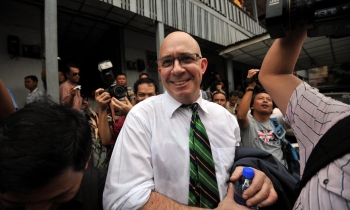NEW YORK: The print media, beset by intensifying competition for advertising dollars, are seeking to strike back.
Trade organizations for the U.S. newspaper and magazine industry are planning elaborate and expensive campaigns that tackle a daunting task: persuading marketers and agencies to think better of print as an ad medium.
The industry is contending with sluggish growth as it faces off against the Internet, e-mail marketing and other newer rivals.
The magazine campaign is scheduled to start first, on Feb. 27, with a series of ads for the Magazine Publishers of America from Mullen in Wenham, Massachusetts. The campaign, which was to be formally announced Wednesday, is the second part of a three-year, $40 million effort on behalf of the magazine industry.
The focal point of the magazine campaign will be ads for eight brands and products like Altoids mints, sold by Kraft Foods; Cover Girl makeup, made by Procter & Gamble; the Infiniti car line, sold by Nissan Motor; and J.C. Penney department stores.
The ads are slyly designed to look as if they had been ripped from the magazines in which they appear. Text next to the torn-out ads makes the point that magazines engage readers with "ideas that live beyond the page."
The newspaper campaign, to be announced Monday, is scheduled to begin on March 20. It is being created by the Martin Agency in Richmond, Virginia, for the Newspaper Association of America, which hopes that its members will donate as much as $50 million of ad space to run the campaign this year.
The newspaper campaign takes a humorous tack to pitch the virtues of buying ad space. One ad, for instance, declares: "Every day we try to print something that people on the right and the left can actually agree on. We call it 'advertising."'
The campaign asserts that the advertising in newspapers, unlike that in some other media, like Web sites, is "a destination, not a distraction."
Both trade organizations have recently run campaigns aimed at the advertising industry. But the need for the print media to make their case in a more noticeable, even intrusive, manner is growing as their share of advertising revenue shrinks.
"I'm surprised they haven't tried to do something like this sooner," said Lauren Rich Fine, who follows the ad industry for Merrill Lynch. "There's still value in print advertising, but advertisers are assessing the return they're getting from it."
Previously, sluggish growth for newspaper ad revenue was typically attributable to a poor economy or even a recession, said a specialist in the newspaper industry, Miles Groves of MG Strategic Research in Washington.
But now, "there's more going on here than a cycle," he said, as many marketers "look for better ways to tell their stories, like more investment in direct marketing, one-to-one marketing, online marketing."
John Kimball, chief marketing officer at the newspaper association, based in Vienna, Virginia, acknowledged that newspapers were "somehow, in the minds of many people, a medium that's in this great trouble."
"When you dig a little deeper, we have a compelling story," he said, "but we didn't tell it to anybody." So the newspaper association returned to Martin, with which it worked on a campaign in 2003, and met with other agencies and advertisers.
From that came a decision to focus the campaign on the idea that consumers may "buy subscription radio to avoid commercials, TiVo commercials on TV and hate pop-up ads on the Internet," Kimball said, "but would not want to read a newspaper that did not contain advertising."
The newspaper industry is "spending a lot of time on the defensive," said Earl Cox, partner and chief strategy officer at Martin, part of Interpublic Group. "A lot of people have written off newspapers as old-school and static, but consumers don't just read newspapers, they use them, to research and shop for the things they want to buy."









